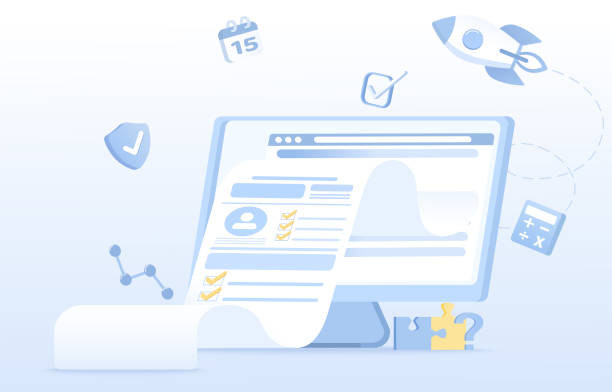Introduction to Personal Website Design and Its Importance
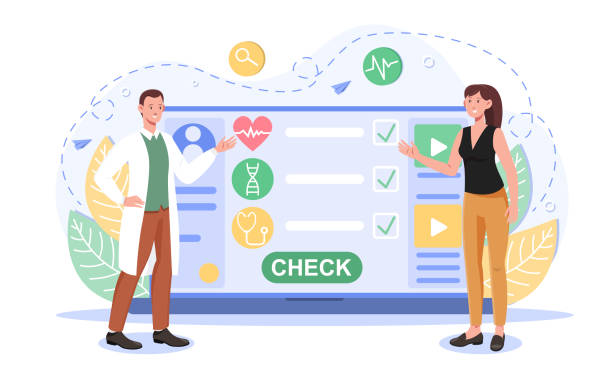
In today’s world, where the boundaries between the real and virtual worlds are blurring every day, having a strong online presence is not just an advantage, but a necessity.
Designing your personal website, as your digital storefront, plays a vital role in building your personal brand, showcasing your skills, and connecting with your audience.
This dedicated platform allows you to tell your story without the limitations of social networks and gives you complete control over your #content and #presentation.
Your personal website can serve as an online portfolio for artists and designers, an interactive resume for professionals, or even a virtual office for freelancers.
The importance of this space is that you own it and set the rules, not the changing algorithms of other platforms.
It’s a long-term investment in your career and personal journey that provides countless opportunities for #networking, attracting clients, and #showcasing_your_services_and_products.
By having a website, you display your credibility and professionalism and will be more memorable in the mind of your audience.
Your website is a command center for all your online activities.
Lagging behind big online stores?
RasaWeb makes your business online with professional e-commerce website design and increases your market share!
✅ Increase brand credibility and customer trust
✅ Easy shopping experience leads to more sales
⚡ Act now for a free website design consultation!
Initial Planning Steps for Building a Personal Website
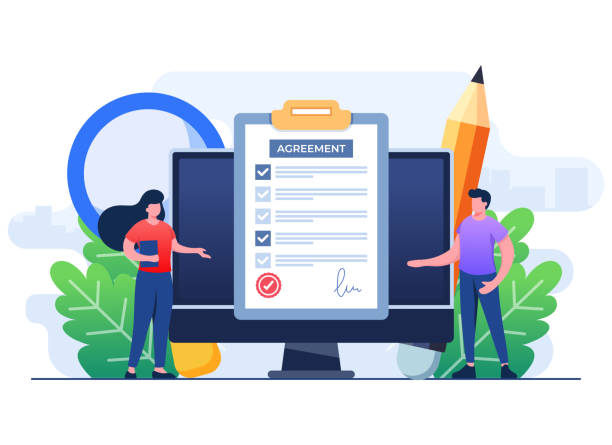
Before you get started with designing your personal website, careful and purposeful planning is essential.
The first step is to determine the main goal of creating the website.
Do you intend to showcase your skills? Offer specific services? Or simply publish educational and analytical content? Understanding your target audience is also of high importance.
Knowing who your website visitors will be helps you tailor your content and design to their needs and expectations.
Choosing an appropriate domain name is the first step in establishing your online identity.
The domain name should be short, memorable, relevant to your activity, and available.
After that, it’s time to choose a reliable and efficient hosting service that guarantees the speed and stability of your website.
Planning the website structure (main pages, about us, contact us, portfolio, blog, etc.) and the type of content to be placed on it (text, photos, videos, infographics) are also initial and crucial steps.
A clear roadmap helps you proceed with the website design process in an organized and efficient manner and prevents confusion.
Choosing the Right Platform and Tools for Personal Website Design
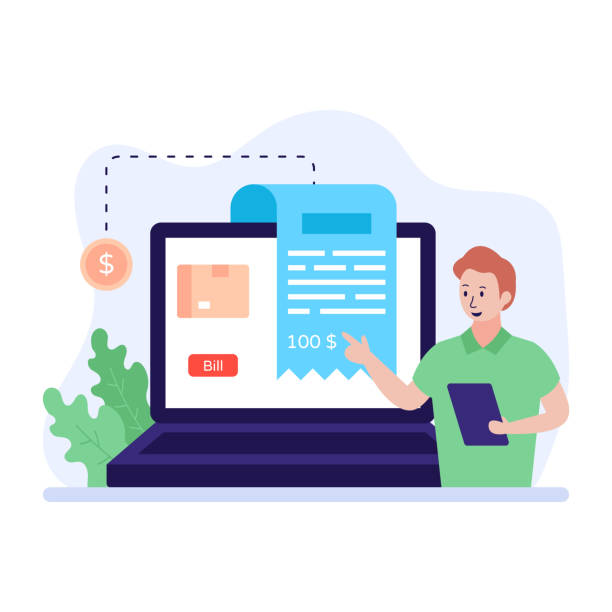
Choosing the right platform is one of the key decisions in the personal website design process.
You have several options, each with its own advantages and disadvantages.
Content Management Systems (CMS) like WordPress are among the most popular and flexible options, suitable for almost any type of website.
WordPress, offering thousands of themes and plugins, provides unparalleled customization possibilities and is usable even for individuals with limited technical knowledge.
Platforms like Squarespace and Wix are also good options for building personal websites with a “drag-and-drop” approach that require no coding and are very suitable for beginners.
These platforms mostly offer beautiful and user-friendly designs.
In contrast, for those who prefer full control and deeper customization, custom coding with languages like HTML, CSS, and JavaScript can be a suitable option, although it requires more technical knowledge.
Platform selection should be based on your technical knowledge level, budget, specific website needs, and the degree of customization required.
Each of these options provides different tools and capabilities for showcasing your portfolio, blogging, and presenting your services.
| Feature | WordPress | Wix | Squarespace |
|---|---|---|---|
| Ease of Use | Medium (requires initial learning) | Very Easy (drag and drop) | Easy (beautiful designs) |
| Customization Capability | High (with plugins and coding) | Medium | Medium to High |
| Cost | Medium (hosting, domain, theme/plugins) | Medium to High (subscription plans) | Medium to High (subscription plans) |
| SEO Friendly | Excellent (with specialized plugins) | Good | Good |
| Who is it suitable for? | Bloggers, businesses, professional portfolios | Individuals and small businesses, simple portfolios | Artists, photographers, designers (focus on visual aesthetics) |
User Interface and User Experience (UI/UX) Design in Personal Websites
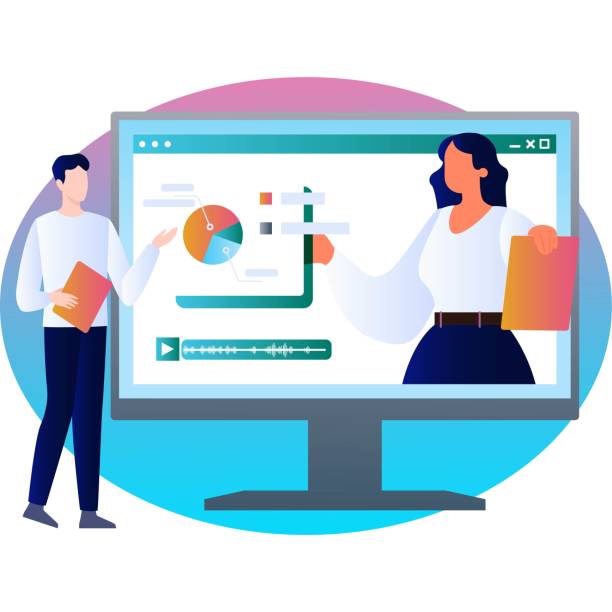
In today’s competitive world, your personal website design must not only be beautiful but also provide a pleasant and hassle-free experience for visitors.
This is where the concepts of User Interface (UI) and User Experience (UX) become important.
UI refers to the visual appearance and feel of the website; including colors, fonts, layout, and graphic elements.
UX, however, goes beyond aesthetics and addresses the overall user experience when interacting with the website; is the navigation easy? Is information easily found? Does the website load quickly? A strong UI/UX can be the difference between a user staying on your website or leaving immediately.
To design a website with excellent UX, you should focus on intuitive and logical navigation (menus and links), fast loading speed, responsiveness (Responsive Design) for correct display on all devices (mobile, tablet, desktop), and content readability.
Using appropriate white space, clear visual hierarchy, and clear Calls-to-Action guides users towards your goal.
Remember that your website should reflect your personality and brand, but at the same time, prioritize user comfort and needs to create an unforgettable user experience.
Losing potential customers due to an unprofessional website? RasaWeb is your answer! With our specialized corporate website design services, you can:
✅ Enhance your business’s credibility and standing
✅ Attract more targeted customers
⚡ Act now for a free consultation!
Content is King: Creating Engaging Content for Your Personal Website
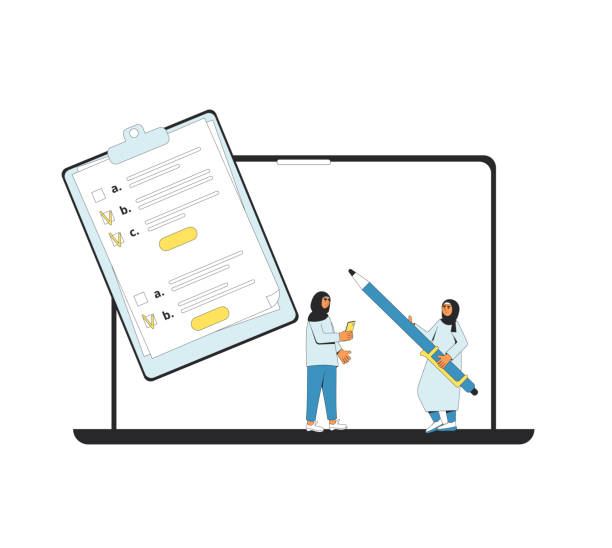
After completing your personal website design, it’s time for the most important part: content creation.
Content is the soul of your website and the main factor in attracting and retaining your audience.
For a personal website, content can include many items: an “About Me” section that attractively narrates your story, experiences, and achievements; a “Portfolio” or “Works” section that showcases your best works; a blog where you can share your ideas, insights, and knowledge; and of course, contact information and communication channels.
It’s important that your content is engaging, useful, and relevant to your expertise.
Use high-quality images and videos to have stronger visual content.
Your writing style should be consistent with your brand personality; it can be formal, friendly, specialized, or entertaining.
Another important point is regular content updates.
Active websites that constantly publish new content are more attractive to users and receive higher scores from search engines.
Remember that every piece of your content should have a purpose, whether it’s informing, encouraging action, or simply building an emotional connection with the audience.
Quality content not only demonstrates your expertise but also helps you become recognized as an authority in your field.
Search Engine Optimization (SEO) for Your Personal Website Design

Even the most beautiful and functional personal website design is useless without being seen.
This is where Search Engine Optimization (SEO) comes into play.
SEO is a set of techniques that helps your website rank higher in Google and other search engine results, allowing more people to find it.
To improve your personal website’s SEO, you first need to identify keywords relevant to your field of activity.
Naturally incorporate these keywords into your titles, meta descriptions, content text, and even image names.
Ensure your website is responsive and displays well on mobile devices, as Google prioritizes mobile-friendly websites.
Website loading speed is also an important SEO factor; the faster your website loads, the better user experience it provides, and search engines like it more.
Using heading tags (H1, H2, H3), optimizing images (size and alt tags), and creating relevant internal and external links all contribute to improving your ranking.
SEO is an ongoing process and requires analysis and updates to stay ahead in online competition and attract targeted traffic to your personal website.
Security and Maintenance of Your Personal Website: Tips for Sustainability

After investing time and effort in personal website design and producing valuable content, maintaining its security and stability is crucial.
A personal website, like any other digital asset, is exposed to security threats such as malware attacks, hacking, and data breaches.
Installing an SSL (Secure Sockets Layer) certificate is the first step in ensuring security, encrypting communication between the website and visitors, and building user trust.
Regularly updating the Content Management System (CMS), themes, and plugins is another essential measure, as older versions often have security vulnerabilities.
Also, creating regular backups of all website files and databases protects you from data loss in case of any issues.
Regular monitoring of the website to identify suspicious activities, reviewing server logs, and using security tools such as a Web Application Firewall (WAF) are also recommended.
Website maintenance includes performance optimization to ensure high speed and efficiency, database cleanup, and checking for broken links.
By observing these tips, you can ensure the stability, security, and efficiency of your personal website and protect your investment.
| Factor | Description | Frequency |
|---|---|---|
| SSL Installation | Encrypting communications and increasing user trust (HTTPS) | Once (annual renewal) |
| CMS/Theme/Plugin Updates | Applying the latest security patches and improving performance | Weekly/Monthly |
| Backup | Creating copies of website files and database | Weekly/Monthly (depending on changes) |
| Security Scan | Checking the website for malware and vulnerabilities | Monthly/Quarterly |
| Speed and Performance Check | Using tools like Google PageSpeed Insights | Monthly |
| Broken Link Check | Ensuring all internal and external links function correctly | Quarterly |
Promoting and Advertising Your Personal Website After Launch

After completing your personal website design and ensuring its proper functioning, the next step is to promote and advertise it.
Having a great website is useless if no one knows it exists.
One of the most effective ways to attract traffic is to share website content on social media relevant to your field of activity.
Linking to your website in social profile bios, publishing regular posts containing links to new articles or portfolios, and interacting with your audience can drive significant traffic to your website.
Collecting visitors’ emails and building an email list allows you to stay in touch with your audience and directly send them new content, newsletters, or special offers.
Participating in online forums, specialized groups, and relevant blogs, and placing your website link in your signature or in response to others’ questions (in a non-spammy way), can help increase your website’s visibility and credibility.
Using web analytics tools like Google Analytics to monitor user behavior and traffic sources provides valuable information for improving your marketing strategies.
Remember that promoting a website is a continuous process and requires continuous effort and creativity to achieve desired results.
Is your company’s website performing as well as your brand deserves? In today’s competitive world, your website is your most important online tool. RasaWeb, specializing in professional corporate website design, helps you to:
✅ Build credibility and customer trust
✅ Convert website visitors into customers
⚡ Get a free consultation now!
Performance Analysis and Continuous Improvement of Personal Websites
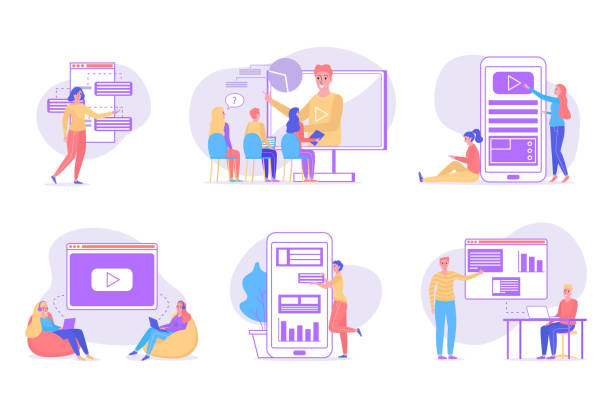
Success in personal website design is not limited to its launch; it requires continuous analysis and ongoing improvement.
To ensure your website achieves its goals, you need to regularly review its performance.
Tools like Google Analytics provide comprehensive information about the number of visitors, their time spent on the site, pages visited, and traffic sources.
By analyzing this data, you can identify your website’s strengths and weaknesses.
For example, if a page has a high bounce rate, it might indicate that the content is not engaging or its design needs improvement.
Listening to user feedback is also very important.
You can place survey forms on your website or solicit feedback via email.
Based on data and feedback, you can make informed decisions to optimize your website; including content improvement, loading speed optimization, changes in UI/UX design, or refining your SEO strategy.
Running A/B tests to compare two versions of a page or a specific element can also help you find the best performance for your website.
This iterative process of analysis, implementation, and monitoring helps you keep your personal website optimized and achieve the best results.
The Future of Personal Website Design: Emerging Trends

The world of personal website design is constantly changing and evolving, and being aware of emerging trends can help you prepare your website for the future.
One of the most important trends is the increasing importance of personalizing the user experience.
Websites are moving towards providing content and user interfaces tailored to the needs and interests of each visitor.
This can include suggested content based on browsing history, or even changes in website layout.
Artificial intelligence (AI) and machine learning are also playing an increasing role in web design, from automating design processes to improving user experience with chatbots and voice assistants.
Minimalist and functional designs focusing on content and simplicity will remain popular.
The importance of website speed and performance will also grow more and more with the advent of 5G networks and increased user expectations.
Augmented reality (AR) and virtual reality (VR) also have the potential to enter the web experience, especially for interactive portfolios and art websites.
Ultimately, personal website design is moving towards platforms that increasingly focus on deep user interaction, accessibility for all, and audio-visual communication.
By understanding these trends, you can keep your personal website dynamic and relevant to future needs.
Frequently Asked Questions
| Question | Answer |
|---|---|
| 1. What is a personal website? | A website created by an individual to showcase personal information, resume, portfolio, interests, or blog. |
| 2. Why is having a personal website important? | It allows you to have a professional online presence, showcase your skills and experiences, connect with others, and manage your digital identity. |
| 3. What content should I include on a personal website? | Typically includes an About Me page, resume, portfolio, contact information, blog (optional), and gallery (if needed). |
| 4. How do I choose a suitable domain name for a personal website? | It is best to use your first and last name (e.g., yourname.com). Choose a short, memorable name relevant to your identity. |
| 5. Do I need coding knowledge to design a personal website? | No, using Content Management Systems (CMS) like WordPress or Website Builders like Wix or Squarespace, you can build your website without coding. |
| 6. What is hosting and what type of hosting is suitable for a personal website? | Hosting is the space where your website files are stored to be accessible to the public. For a personal website, Shared Hosting is usually sufficient and cost-effective. |
| 7. What is the importance of Responsive Design for a personal website? | Responsive design ensures that your website is displayed correctly and with a suitable appearance on all devices (computer, tablet, mobile), which is crucial for an excellent user experience. |
| 8. How can I optimize my personal website for search engines (SEO)? | By using relevant keywords, producing high-quality content, optimizing images, appropriate URL structure, and gaining backlinks, you can improve your website’s SEO. |
| 9. How do I keep my personal website updated? | Regularly add new content (such as blog posts or new portfolio items), keep contact information up-to-date, and ensure that used software and plugins are current. |
| 10. Can I monetize my personal website? | Yes, you can earn income by selling your products or services, advertising, affiliate marketing, or providing specialized consultations, depending on your content and goals. |
And other services of RasaWeb advertising agency in the field of advertising
Smart Marketing Automation: A combination of creativity and technology to increase click-through rates by designing attractive user interfaces.
Smart Social Media: An effective tool to increase sales with the help of real data.
Smart SEO: Revolutionize sales with the help of real data.
Smart Link Building: A creative platform to improve digital branding with Google Ads management.
Smart Custom Software: A combination of creativity and technology to increase click-through rates by using real data.
And over a hundred other services in the field of online advertising, advertising consulting, and organizational solutions
Online Advertising | Advertising Strategy | Advertorials
Sources
How to design a successful personal website?
Personal Branding with a Website
Step-by-step guide to personal website design
The importance of a personal website for business
? RasaWeb Aafarin Digital Marketing Agency, by providing comprehensive and innovative services, from fast website design to complex SEO strategies, paves the way for your business’s success in the online space.
📍 Tehran, Mirdamad Street, next to Bank Markazi, Kazerun Jonubi Alley, Ramin Alley, No. 6

